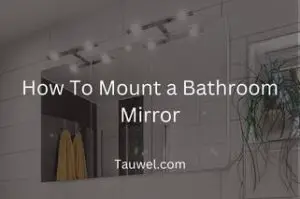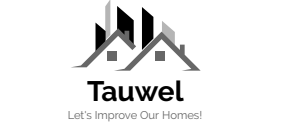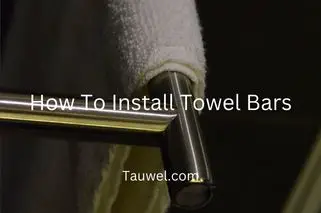This post contains affiliate links. Read the full disclosure here.
Having a mirror is one of the most essential features of your bathroom. It is not only functional but can also elevate the aesthetics of your place. Handling and installing a bathroom mirror can be quite daunting, especially for someone who isn’t experienced with it. Doing it the wrong way can end up damaging your walls or your mirror. Let’s look at a step-by-step guide on how to install a mirror in your bathroom.

The easiest method to install small to medium-sized mirrors on any surface is using adhesives such as silicone or Mastic. Simply clean the area from any dust or debris, apply the adhesive to the mirror, leaving 1-2 inches of space from the sides. Press the mirror onto the wall, and add a support beam at the bottom till dry.
Contents
Factors To Keep in Mind Before the Installation Process
Installing a mirror has a lot of factors to it, like the wall type, the mirror weight, type, etc.
In a Hurry? Don’t go without checking this TRENDING Topic Out - 6 Best Towels For Blackstone Griddle In 2022 out
The first step is to measure the weight of the mirror itself; some installation processes are ideal for certain weight classes. You can measure the weight by using a bathroom scale or simply use the product description to find the correct weight.
Most mirrors also come with mounting hardware included in the back like a wire, D-rings, clips, or brackets.
The next step is to determine the wall type in your bathroom. Depending on whether you have plaster walls, dry walls, brick walls, or lathes, the installation process can also be different.
After this, look out for any obstacles in the mounting area like uneven walls or studs, wires, and pipes behind the walls. This can be done using a stud finder which you can get at any hardware store.
Things You Need to Get Started
It is always better to be prepared and have everything you need for the process. Most of the items can be found in any household or at the local hardware store.
You will need a pencil, a level, measuring tape, painter’s tape, a stud finder, a screwdriver, a drill including the drill bits, and a hammer.
How To Install a Vanity Bathroom Mirror Using Clips
Using mirror clips is the ideal method for installing small to medium-sized frameless mirrors, although it can be used with other kinds of mirrors as well.
- First, place the mirror on the wall and mark the edges around it using a pencil. Now take the mirror away and make sure the marked edges are properly aligned using a spirit level. Draw straight lines between the edges along the level.
- To use a spirit level, notice the bubble in the tube, it should be equally spaced between the two black center lines.
- If there are any studs in the wall, use a stud finder and mark their locations on the wall. If there are no studs, there is no need to worry, you can simply use a wall anchor to support the mirror weight.
- Measure the dimensions of the clips and mark the points towards the bottom area on the wall where the clips will be placed. Leave a 1/2 -1-inch gap between the edges of the mirror to accommodate the size of the clip.
- Evenly space out the clips throughout the bottom edge of the mirror. Ensure that the clip markings are also properly aligned.
- Use a spirit level and draw straight vertical lines from the bottom clips to the top edge. Along these vertical lines, mark the points where the top clips will be placed. Again, leave some space from the edge to accommodate the clip dimensions.
- Drill pilot holes into the marked points and install the bottom clips first. You will need a power drill for this. If there are no studs, install a wall anchor after the pilot holes to ensure a proper grip for the clips.
Pay attention that the bottom clips are usually ‘U’ shaped, and the top ones are ‘L’ shaped.
- Now place the mirror onto the clips and screw in the rest of the top clips to secure the mirror.
How To Install a Mirror Using Adhesive?
- Like the previous method, hold up the mirror against the wall and mark the edges. Take the mirror away and ensure that the markings are aligned using a spirit level.
- Place some painter’s tape along these straight lines about 1 inch inside. Keep in mind that using adhesives as an installation method will end up damaging your walls and even your mirror if you try to remove it later.
- Prep the area inside the tape by cleaning the paint or tiles, if you have a tiled wall. This is done to ensure a strong bond with the adhesive. A lot of household paints have additives that make it harder for adhesives to stick.
- Place a temporary wooden brace along the bottom edge to support the mirror until the adhesive dries off. You can use plywood for this.
- Use a high-grade adhesive like Mastic or silicone, which is also used in construction. You can get these from any hardware store. Apply the adhesive to the back of the mirror and don’t apply it too close to the edges. Leave at least 1-2 inches for the glue to spread when pressed against the wall.
- Press the mirror against the wall and let it rest against the brace at the bottom. Press firmly and leave it to let it dry for 24 hours. Remove the brace after.
A Step-By-Step Guide to Installing Bathroom Mirrors Using Hanging Cleats
Hanging cleats is a good method when dealing with thin or frameless mirrors that don’t weigh more than 4 kg or 10 pounds.
The cleats come in pairs, the top part will be attached to the mirror and the bottom part will be attached to the wall. Both the parts are then aligned together to let the mirror hang.
- Place the mirror on the wall and mark the center point on the top edge.
- Using a screwdriver, attach the top part of the cleat to the top of the mirror. Leave about a 1-inch gap between the edge and the holes. Make some started holes in the back of the mirror and drive the screws in using a screwdriver.
- Using a power drill, place the bottom cleat on the wall. Use a level to make sure it is properly aligned before drilling the holes. Also, ensure that the marked center point on the wall is aligned with the cleat.
- Slide the top cleat on the mirror onto the bottom cleat on the wall. Again, ensure that the mirror is level and you are good to go.
How To Install a Mirror Using Mounting Hooks?
Using mounting hooks is ideal when you are dealing with framed mirrors that can weigh up to or more than 30 pounds.
- Check the back of the mirror to see if there are D-rings already present, if not, attach D-rings to the back of the mirror. Place them horizontally across the mirror, leaving a 1-2 inches gap between the edges of the frame. Ensure that they are properly leveled.
- Measure the distance between the D-rings at the back of the mirror as well as the distance between the top of the mirror and the rings.
- Place the mirror on the wall and mark the top edges of the mirror including the center point.
- Using the measurements, mark the points where the holes need to be drilled for the hooks to be attached. This would be the distance between the rings at the back of the mirror and the distance from the top of the mirror.
- Drill holes into the wall and place anchors in case there are no studs available. Hang the mirror onto the hooks and let it go carefully, only after being sure that the rings are properly placed within the hooks.
- Finally use a leveler to ensure that the mirror is straight.
Installing a bathroom mirror is very similar to hanging pictures, which you can read more about in my article: How to Hang a Picture Using a Level. There I talk in more detail about how to use a level properly.
How To Install a Frameless Mirror?
Using mirror clips or adhesives are the two best methods to install a frameless mirror. Make sure the mirror thickness matches the clip thickness. There are a lot of options for clips available in the market, both in terms of functionality and design variations. Although most mirrors come with their own set of clips.
Tips For Hanging a Heavy Mirror on Drywall
When dealing with drywall, use a 1 ¼ inch or 1-1/5-inch screw if you are going to be screwing into a stud. This measurement is for a standard ½ inch drywall.
On the other hand, if you don’t have studs, you will need a drywall anchor to support the weight of the mirror. You can use sleeve expansion anchors for lighter-weight mirrors while toggle bolts are recommended for heavier objects. You can also use Molly bolts, and self-drilling drywall anchors, as well.
To install the anchors, simply drill a pilot hole and then insert and tap the anchor to make it flush with the wall. Insert the screw into this anchor before moving on with the installation process. The sleeve expansion anchor will expand inside the wall when you insert a screw into it using a screwdriver or drill.
Tips For Hanging a Heavy Mirror on Plaster
Plaster walls don’t offer as much grip strength or support compared to brick or drywall. If drilling into a stud, you will only need 3-inch screws to get through the 1-inch plaster wall and 2 inches into the stud itself.
If you don’t have studs in the area, you can also use a toggle bolt or any other hollow wall anchor. You can also opt for molly bolts, or a metal toggle bolt if your mirror is especially heavy. For both, drill pilot holes into the wall and insert the entire bolt into the wall. Tighten the bolt once it is inside to make it expand and remove the threaded screw.
For the toggle bolt, thread the toggle onto the bolt which will make the wing open towards the wall. With the wings folded down, push the toggle through the pilot hole which will make the wings open once it is inside. Finally, pull it towards you to secure the bolt.
Tips For Hanging a Heavy Mirror on Brick Walls
While dealing with brick or masonry walls, you will again need some specific kinds of anchors. A masonry sleeve anchor will get the job done for almost all mirrors. You will also need other hardware tools like a hammer drill and masonry drill bits.
If you have to drill through ceramic or tiles, use a glass and ceramic drill bit which prevents any cracking or shattering when you drill a hole into them.
Tips For Leveling Different Types of Mounting Hardware
Making sure the mirror is going to be perfectly aligned is one of the most important and difficult things to do in the entire process. Let’s look at some tips about how to do this with different hardware types.
When dealing with brackets, start measuring from the top of the mirror to the bracket as well as the length of the bracket itself. Transfer these measurements to the wall and start with the middle screw to get a good placeholder to level out the rest of them.
With D-rings or Keyholes, follow a similar approach of measuring from the top of the mirror to the top of the D-ring. After this, note the distance between the two mounting points. When transferring these measurements to the wall, pay close attention to the alignment of the two points.
Dealing with a wire is the most complicated because you must choose the mounting points independently. It is recommended to mount using two points to distribute the overall weight and to keep the mirror from swaying. Raise the wire up to a point where there is tension in the wire and find the two points where you want the mirror to hang from. Don’t keep them too close together.
Measure the distance between these two points and the distance between the point and the top of the mirror. Make sure the two points are level when transferring these measurements to the wall.
Conclusion
There are a lot of mounting techniques which you can choose from when it comes to mirrors. Hanging cleats, clips, hooks, and adhesives are some of the most common methods. The latter should only be used when dealing with lighter and smaller mirrors. The most important aspect is hanging the mirror straight which can be achieved using a spirit or laser level. You also need to pay attention to the type of wall you have. If dealing with lathe or plaster, use drywall anchors to provide the extra support needed.


